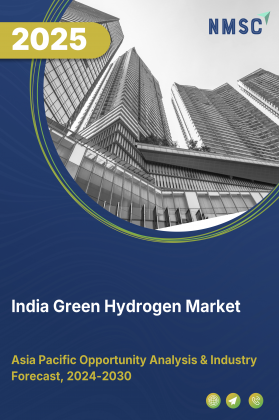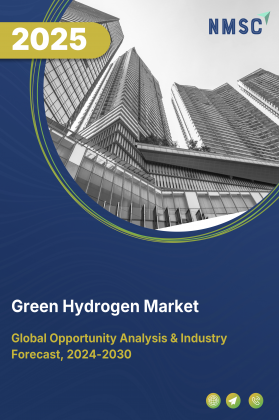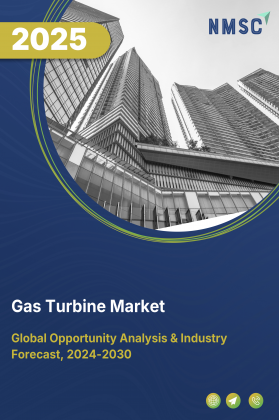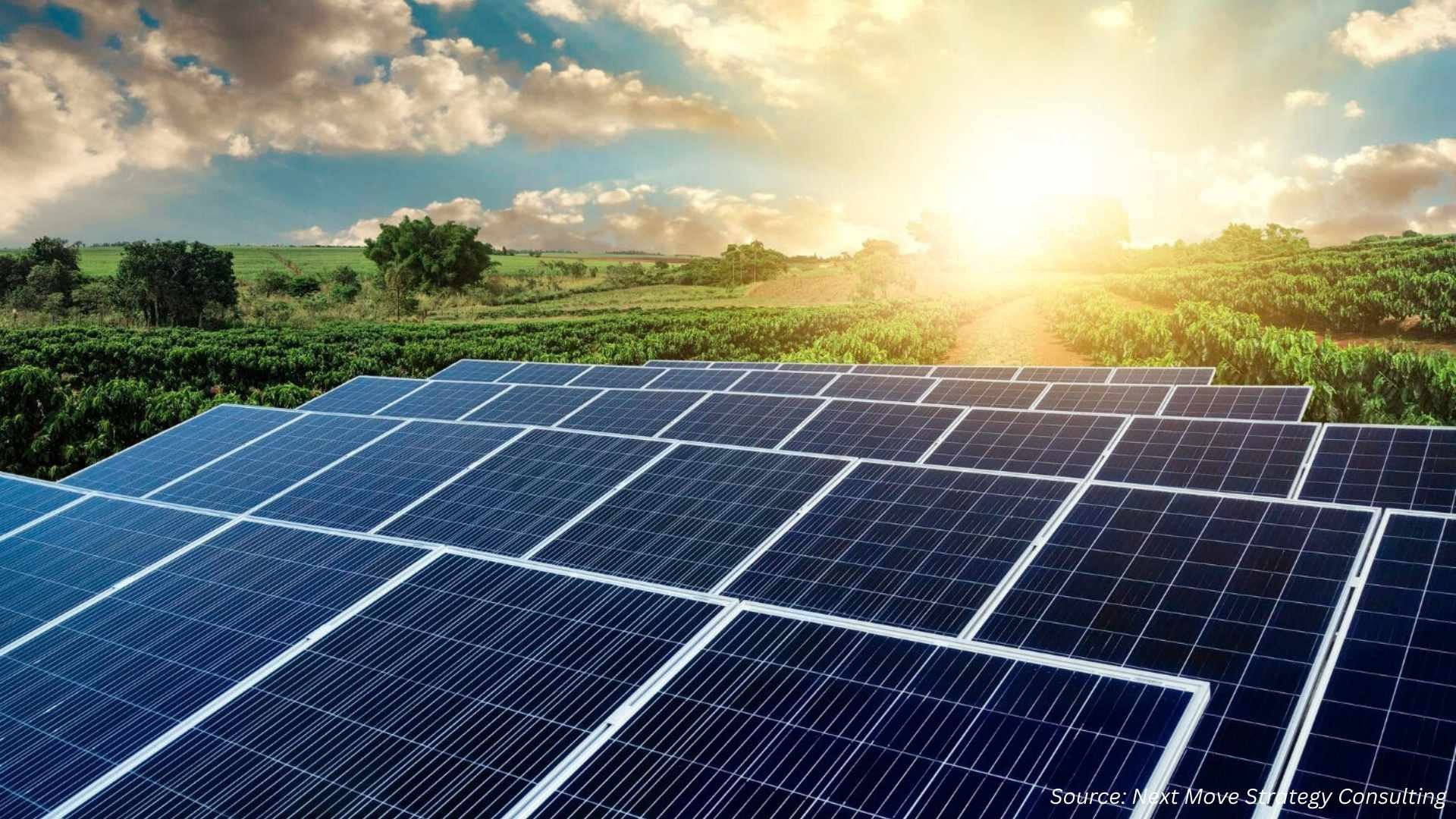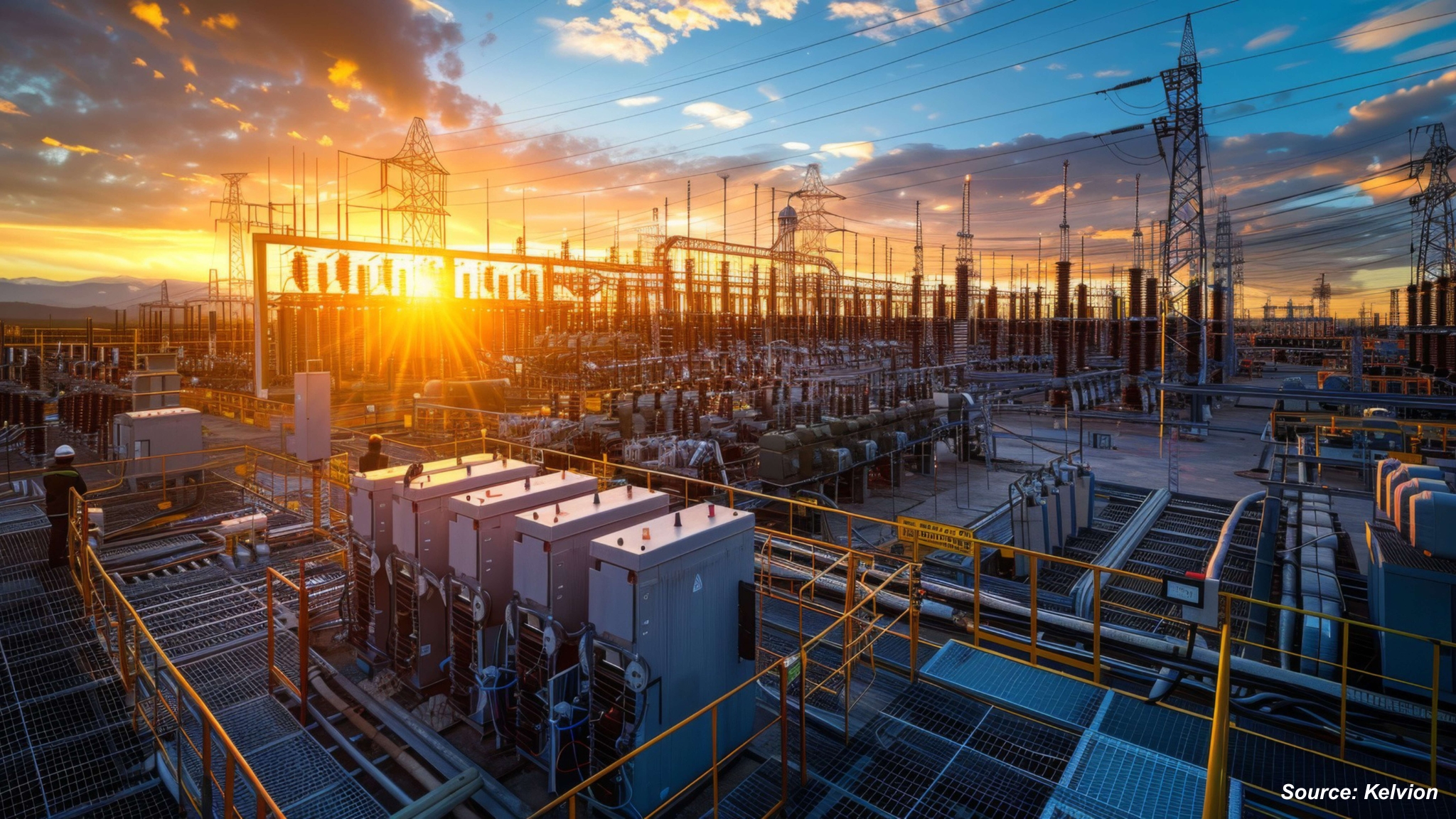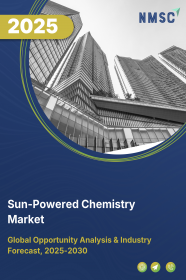
Sun-Powered Chemistry Market by Technology (Photocatalysis, Photovoltaics, and Others), by Scale of Operation (Small-Scale and Large-Scale), by Application (Solar Fuels Production, Chemical Synthesis, and Others), and by End-User (Energy, Pharmaceutical, Agriculture, and Others) – Global Opportunity Analysis and Industry Forecast, 2025–2030
Sun-Powered Chemistry Industry Overview
The global Sun Powered Chemistry Market size was valued at USD XX billion in 2024 and is predicted to reach USD XX billion by the end of 2025. The industry is predicted to reach USD XX billion by 2030 with a CAGR of XX% from 2025 to 2030.
The global push for carbon neutrality is driving significant growth in the market. As industries strive to reduce greenhouse gas emissions, solar-driven chemical processes are emerging as a sustainable alternative to traditional fossil fuel-based production methods. Countries with net-zero targets are investing in solar-powered chemical systems, which use sunlight to create chemicals and fuels with minimal carbon footprints.
Technological advancements in photocatalysts are enhancing the efficiency of these systems, making them more commercially viable. At the same time, the rising demand for eco-friendly chemical processes is further fueling the market. However, high initial capital investments remain a key challenge, especially for small and mid-sized enterprises. AI-driven optimization is offering new opportunities to increase hydrogen yield and efficiency, helping companies improve performance while reducing costs in the evolving green energy landscape.
Global Push for Carbon Neutrality Drives the Sun-Powered Chemistry Growth of the Market
As industries aim to reduce greenhouse gas emissions, sun-powered chemistry market trend is emerging as a viable solution to create chemicals and fuels with a minimal carbon footprint. Countries implementing net-zero targets are increasing investments in solar-driven chemical systems to replace fossil-fuel-intensive production methods. For instance, the European Union’s “SunCoChem” initiative supports using sunlight for synthesizing platform chemicals from CO₂, aligning with the EU Green Deal. This policy-backed transformation is fueling demand for renewable synthesis platforms across chemical, energy, and material industries.
Photocatalyst Advancements Enhance Efficiency and Drive Market Expansion
Rising developments in photocatalysts are enhancing the viability of solar-powered chemistry at an industrial scale. Advanced materials like metal-organic frameworks (MOFs), bismuth vanadate, and perovskites are significantly improving light absorption and electron transfer efficiencies. A 2024 study in ACS Applied Energy Materials demonstrated a photocatalytic system that splits water with record efficiency, using visible light to generate green hydrogen. These innovations are expanding the practical applications of sun-driven synthesis and making commercial deployment increasingly feasible.
Rising Demand for Sustainable Chemical Processes Fuels Sun-Powered Industry Market Growth
As consumers and stakeholders prioritize environmental responsibility, manufacturers are under pressure to transition toward eco-friendly production. Sun-powered chemistry market demand enables the use of solar energy for producing valuable outputs like methanol, syngas, and fertilizers without burning fossil fuels. Companies such as Sekisui Chemical are pioneering perovskite-solar chemical integration, demonstrating the commercial potential of zero-emission chemical platforms. This growing demand for sustainable industrial chemistry is pushing innovation and adoption of solar-driven processes across sectors.
High Initial Capital Investment Hinder Sun-Powered Chemistry Market Trends
Despite long-term sustainability benefits, setting up sun-powered chemical systems requires substantial upfront costs. Investments in solar reactors, high-performance catalysts, system integration, and process control infrastructure are typically high. For small and mid-sized enterprises, this cost can be prohibitive without policy incentives or strong ROI evidence. According to ChemAnalyst, companies hesitate to retrofit existing operations unless supported by robust subsidy frameworks or proven short-term gains.
AI-Driven Optimization Enhances Hydrogen Yield and Efficiency Create Opportunity for Market Growth
Artificial Intelligence (AI) is unlocking new levels of precision and efficiency in solar-powered hydrogen production. By leveraging machine learning algorithms, researchers optimize catalyst design, predict reaction pathways, and dynamically adjust operational parameters based on real-time solar irradiance and atmospheric conditions. For instance, AI models developed by teams at MIT and the University of Cambridge have been used to fine-tune photocatalytic reactions, increasing hydrogen output while minimizing energy loss. This fusion of AI with solar chemistry is not only accelerating R&D cycles but also enabling scalable, autonomous hydrogen systems, offering industry players a critical competitive edge in the evolving green fuel landscape.
For instance, AI models developed by teams at MIT and the University of Cambridge have been used to fine-tune photocatalytic reactions, increasing hydrogen output while minimizing energy loss. In a recent 2025 milestone, Honeywell launched its AI-powered Hydrogen Plant Optimization Suite, designed to boost performance across green hydrogen facilities through predictive analytics and autonomous control systems. This fusion of AI with solar chemistry is not only accelerating R&D cycles but also enabling scalable, self-regulating hydrogen systems, offering industry players a critical competitive edge in the evolving green fuel landscape.
Market Segmentation and Scope of Study
The sun-powered chemistry market report is categorized on the basis of technology, scale of operation, application, end-user industry, and region. On the basis of technology, the market is divided into photocatalysis, photovoltaics, solar thermal, photoelectrochemical cells (PECs), and others. On the basis of scale of operation, the market is segmented into small-scale and large-scale deployments. On the basis of application, the market is grouped into solar fuels production, chemical synthesis, wastewater treatment, desalination, hydrogen production, and others. On the basis of end-user industry, the market is classified into energy, pharmaceutical, agriculture, water management, food and beverage, and others. Regional breakdown and analysis of each of the aforesaid segments includes regions comprising Asia-Pacific, North America, Europe, and Rest of the World (RoW).
Geographical Analysis
North America remains a pivotal region for sun-powered chemistry market share, propelled by strong federal backing, academic research excellence, and a growing focus on decarbonization. The United States Department of Energy (DOE) has prioritized solar-driven chemical processes, funding projects that convert CO₂ into fuels and materials using sunlight. Research hubs such as MIT, Stanford, and Argonne National Laboratory are working on AI-enhanced solar catalytic systems, bolstering the region’s innovation pipeline. The market trends in this region reflect an increasing alignment between climate policy and commercialization strategies, opening pathways for advanced solar photochemistry, hydrogen production, and sustainable feedstocks. With robust infrastructure and venture capital presence, North America shows strong growth potential and continues to influence the global industry size and direction.
Europe is leading the charge in institutionalizing market share through ambitious green policies and public-private partnerships. Initiatives like the European Green Deal and the Horizon Europe framework are actively funding solar chemical technologies that transform carbon dioxide and water into value-added compounds. Countries such as Germany, the Netherlands, and France are scaling demonstration plants that integrate solar reactors into chemical manufacturing. The market share of sun-powered chemistry in Europe is expected to grow as circular economy practices and carbon neutrality targets gain momentum. Projects like SunCoChem and collaborations with research bodies, including Fraunhofer and CNRS, underscore Europe's position as a regulatory and research-driven powerhouse in the solar chemistry market.
The Asia-Pacific region is emerging as a crucial player in scaling sun-powered chemical technologies, largely due to strong industrial demand and policy support in key economies. China, Japan, and South Korea are investing heavily in solar-based hydrogen and CO₂ utilization technologies to reduce their reliance on fossil-based chemical synthesis. For example, Japan’s Sekisui Chemical launched solar-powered perovskite devices capable of supporting sustainable production in industrial setups. The region is also witnessing growth in public-private R&D collaborations to enhance solar-to-chemical conversion efficiency. As a result, Asia-Pacific holds significant growth potential across sectors, including renewable fuels, specialty chemicals, and industrial gases, positioning itself as a leader in the next phase of clean tech transformation.
Regions falling under the Rest of the World (RoW) category, comprising parts of Latin America, the Middle East, and Africa are currently at early stages of adoption but are gradually recognizing the long-term benefits of solar-driven chemical synthesis. Countries like Saudi Arabia and the UAE are beginning to explore solar chemical pathways as part of their broader green hydrogen and diversification strategies. Meanwhile, Latin American nations with high solar irradiance, such as Chile and Brazil, offer untapped potential for decentralized solar chemical production. Although the market size in these areas remains relatively modest, strategic collaborations, infrastructure investments, and favorable climate conditions present unique niche opportunities for first-movers and technology providers.
Strategic Moves by Key Players in Solar Powered Chemistry
Key players in the global sun-powered chemistry industry are adopting a multifaceted approach to scale innovations, bridge the lab-to-market gap, and establish leadership in this transformative segment of the clean energy ecosystem. Leading companies such as Sekisui Chemical, BASF, and Shell, along with research institutions like EPFL and the University of Cambridge, are investing in solar-to-chemical conversion systems that enable sustainable synthesis of fuels, materials, and hydrogen. Sekisui’s recent deployment of perovskite solar modules in industrial settings, 2024, exemplifies a move toward real-world integration, targeting both cost efficiency and emissions reduction. Similarly, EPFL’s solar water-splitting device, launched in 2025, set a new benchmark in green hydrogen output, showcasing the growth potential of next-generation photocatalytic platforms.
Despite these advances, challenges persist. Scaling solar chemical technologies to industrial levels while maintaining cost-effectiveness and operational reliability remains a core hurdle. Issues like material degradation, low solar-to-chemical efficiency, and intermittency in solar input constrain widespread deployment. Furthermore, the absence of standardized performance metrics and long-term investment models continues to limit broader commercial adoption.
Nonetheless, the path ahead is filled with strategic opportunity. AI-driven optimization, government-backed pilot programs, and cross-sector collaborations are paving the way for breakthroughs. For instance, BASF and Fraunhofer are co-developing solar-powered CO₂-to-methanol systems under EU funding frameworks, signaling rising investor and policy confidence. As regulatory frameworks evolve and decarbonization targets become legally binding, green chemistry technologies presents an attractive frontier for players focused on climate-tech innovation and sustainable industry transformation.
Key Benefits
-
The report provides quantitative analysis and estimations of the industry from 2025 to 2030, that assists in identifying the prevailing market opportunities.
-
The study comprises a deep-dive analysis of the industry including the current and future trends to depict prevalent investment pockets in the market.
-
Information related to key drivers, restraints, and opportunities and their impact on the market is provided in the report.
-
Competitive analysis of the players, along with their market share is provided in the report.
-
SWOT analysis and Porters Five Forces model is elaborated in the study.
-
Value chain analysis in the market study provides a clear picture of roles of stakeholders.
Sun-Powered Chemistry Market Key Segments
By Technology
-
Photocatalysis
-
Photovoltaics
-
Solar Thermal
-
Photoelectrochemical cells (PECs)
-
Others
By Scale of Operation
-
Small-Scale
-
Large-Scale
By Application
-
Solar Fuels Production
-
Chemical Synthesis
-
Wastewater Treatment
-
Desalination
-
Hydrogen Production
-
Others
By End-User
-
Energy
-
Pharmaceutical
-
Agriculture
-
Water Management
-
Food and Beverage
-
Others
By Region
-
North America
-
U.S
-
Canada
-
Mexico
-
-
Europe
-
The UK
-
Germany
-
France
-
Italy
-
Spain
-
Denmark
-
Netherlands
-
Finland
-
Sweden
-
Norway
-
Russia
-
Rest of Europe
-
-
Asia-Pacific
-
China
-
Japan
-
India
-
South Korea
-
Australia
-
Indonesia
-
Singapore
-
Taiwan
-
Thailand
-
Rest of Asia-Pacific
-
-
Rest of the World
-
Latin America
-
Middle East
-
Africa
-
Key Players
-
BASF
-
Sun Chemical
-
L’Oréal
-
Dow
-
Wacker Chemie AG
-
Linde
-
Solar Chemferts Pvt. Ltd.
-
Solar Organics
-
Solar Chemical
-
Chemtex Speciality Limited
-
Heliogen
-
Hanergy
-
Adarsha Specialty Chemicals Pvt. Ltd.
-
Shiseido Company, Limited
-
Covestro AG
REPORT SCOPE AND SEGMENTATION:
|
Parameters |
Details |
|
Market Size in 2024 |
USD XX Billion |
|
Revenue Forecast in 2030 |
USD XX Billion |
|
Growth Rate |
CAGR of XY% from 2024 to 2030 |
|
Analysis Period |
2024–2030 |
|
Base Year Considered |
2024 |
|
Forecast Period |
2025–2030 |
|
Market Size Estimation |
Billion (USD) |
|
Growth Factors |
|
|
Countries Covered |
28 |
|
Companies Profiled |
15 |
|
Market Share |
Available for 10 companies |
|
Customization Scope |
Free customization (equivalent to up to 80 working hours of analysts) after purchase. Addition or alteration to country, regional, and segment scope. |
|
Pricing and Purchase Options |
Avail customized purchase options to meet your exact research needs. |




















 Speak to Our Analyst
Speak to Our Analyst



